“Yes, we are on the move and no wave of racism can stop us. We are on the move now. The burning of our churches will not deter us. The bombing of our homes will not dissuade us. We are on the move now.”
1964 peace laureate Martin Luther King Jr. spoke these words after the end of the Selma to Montgomery marches.
The marches were one of the turning points in the civil rights movement and were organised to protest the blocking of Black Americans' right to vote.
The first march began Sunday, March 7, 1965. A group of 600 marchers, led by Student Nonviolent Coordinating Committee chairman John Lewis and Reverend Hosea Williams of the Southern Christian Leadership Conference, began the 54-mile (87 km) walk from Selma to Montgomery. The march proceeded until the protesters arrived at the Edmund Pettus Bridge. At the bridge, law enforcement officials attacked the marchers. More than sixty marchers were injured.
Cameras captured the scene of peaceful activists being violently attacked. This caused mass outrage and drew civil rights and religious leaders of all faiths to Selma in protest.
Two days later, Martin Luther King Jr. led around 2,000 marchers in another march. The march was again stopped at the same bridge.
On March 21, the third march began with King and activists setting out from Selma. The march took five days. By the time they reached Montgomery their number had grown to more than 25,000, before they gathered to hear King and 1950 peace laureate Ralph Bunche speak.
Five months later, the U.S. Congress passed the Voting Rights Act of 1965 which aimed to correct the barriers preventing African Americans from using their right to vote.
More about peace laureate Martin Luther King Jr: https://www.nobelprize.org/prizes/peace/1964/king/facts/
Martin Luther is often credited with bringing about the Reformation. He exploited the new media of his time—pamphlets, ballads, and woodcuts—to promote his message of religious reform through social networks. Luther was born on this day 1483
Martin Luther is often credited with bringing about the Reformation. He exploited the new media of his time—pamphlets, ballads, and woodcuts—to promote his message of religious reform through social networks. Luther was born on this day 1483
德國著名玩具公司摩比(Playmobil)最近又驚喜又困惑,驚喜的是他們新推出的一款人形玩偶大賣特賣,賣到斷貨,創下公司新記錄;困惑的是,這款玩偶的主人翁,不是卡通人物,不是社交名流,而是一位16世紀的德國神學家。
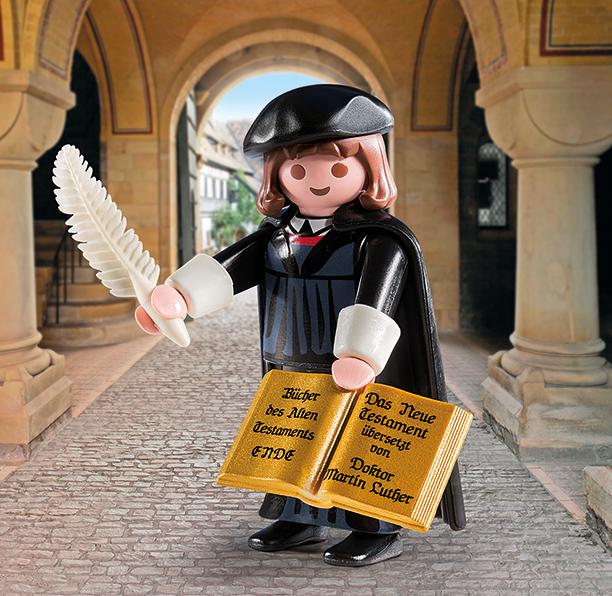
摩比日前宣布,公司出品的馬丁.路德(Martin Luther)玩偶,第一版3萬4000個,短短72小時就被玩家搶購一空。摩比已下令位於馬爾他(Malta)的工廠加緊趕工,但向隅的玩家可能要等到4月底才能把玩「小路德」。
「小路德」是塑膠材質,7.5公分高的人偶之外,附有一支鵝毛筆,一本德文版《聖經》,原本是由德國旅遊局與巴伐利亞信義會(Evangelical Lutheran Church)訂製,目的是慶祝明年的宗教改革(Reformation)500周年。德國旅遊局表示,「小路德」的玩家95%是德國人,不過西班牙、義大利與瑞典的玩家也不少。
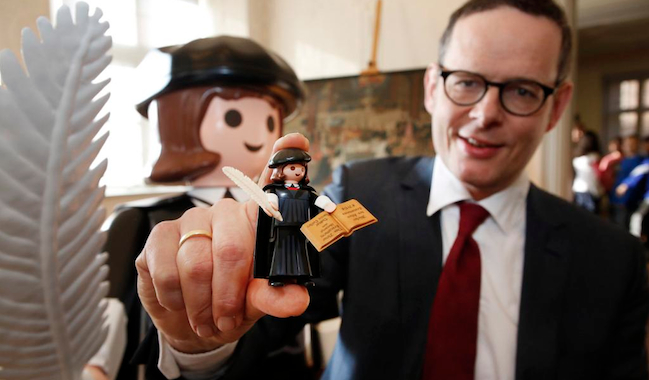 「小路德」到底為什麼會大賣?摩比的主管百思不得其解,但是宗教改革500周年活動承辦主管穆爾曼(Astid Mühlmann)認為,這顯示了德國社會對歷史教育的重視,德國家長希望兒女多認識這位影響深遠的宗教運動者。
「小路德」到底為什麼會大賣?摩比的主管百思不得其解,但是宗教改革500周年活動承辦主管穆爾曼(Astid Mühlmann)認為,這顯示了德國社會對歷史教育的重視,德國家長希望兒女多認識這位影響深遠的宗教運動者。
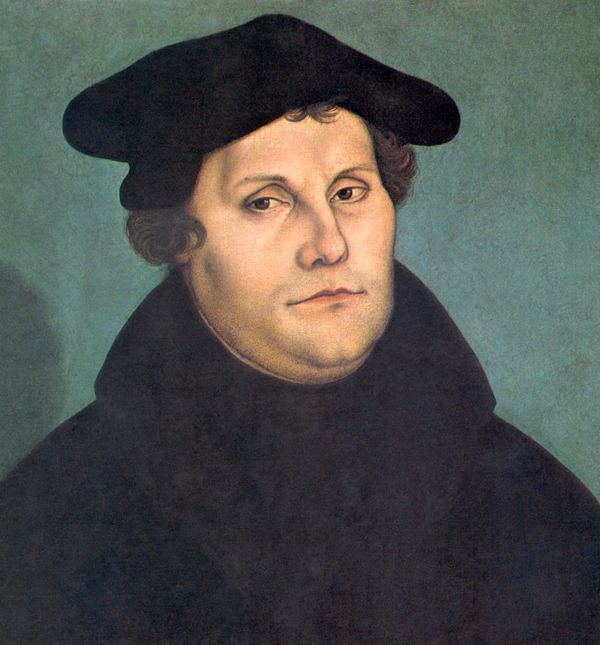 穆爾曼說:「馬丁.路德一方面是個典型的16世紀人,他相信魔鬼和女巫的存在,而且會害怕……另一方面,他也有非常現代化的理念,相信包括女性在內,每個人都有受教育的權利。在這一點上,他是個不折不扣的21世紀人。」
穆爾曼說:「馬丁.路德一方面是個典型的16世紀人,他相信魔鬼和女巫的存在,而且會害怕……另一方面,他也有非常現代化的理念,相信包括女性在內,每個人都有受教育的權利。在這一點上,他是個不折不扣的21世紀人。」
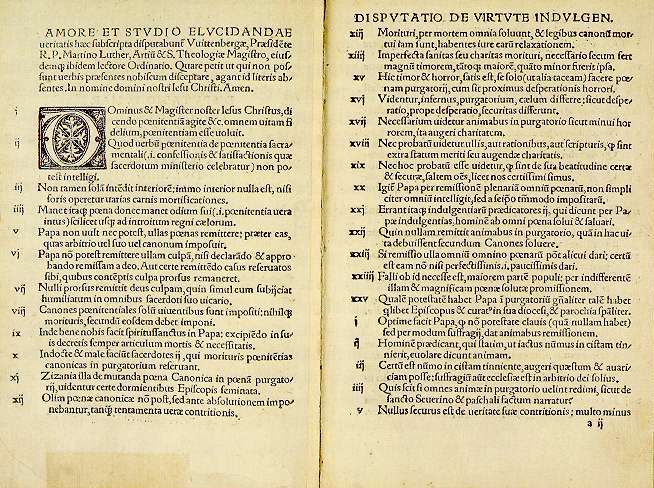 馬丁.路德(1483~1546)原本是天主教神父,1517年發表《九十五條論綱》(Disputatio pro declaratione virtutis indulgentiarum),討論天主教會諸多弊病,尤其痛批教會販賣贖罪券(Indulgentia)的行為,開啟宗教改革的先聲。在神學上,馬丁.路德提倡「因信稱義」(Sola fide),質疑教皇的權威地位。此外,他翻譯的德文《聖經》也促進了德文的發展。
馬丁.路德(1483~1546)原本是天主教神父,1517年發表《九十五條論綱》(Disputatio pro declaratione virtutis indulgentiarum),討論天主教會諸多弊病,尤其痛批教會販賣贖罪券(Indulgentia)的行為,開啟宗教改革的先聲。在神學上,馬丁.路德提倡「因信稱義」(Sola fide),質疑教皇的權威地位。此外,他翻譯的德文《聖經》也促進了德文的發展。




British Museum
#onthisday in 1517: Martin Luther nailed his 95 Theses to a church door, traditionally thought of as sparking the beginning of the Reformation. This broadsheet – published in 1617, on the centenary of the Reformation – depicts the early Reformation of the Christian Church as a prophetic dream of Friedrich III, a political protector of Martin Luther.
Luther is shown writing on a church door with an enormously long pen, referencing the moment he publicly posted his 95 Theses in the town of Wittenberg. The pen stretches across half of the picture to emphasise the importance of the written word to Protestants, as opposed to images which were popular in the Catholicism of the time. The end of the pen passes through the ears of a lion and knocks off the tiara, or crown, of the pope of the time, Leo X, hence the lion. This is a clear reference to Luther’s criticism of the authority of the Pope as head of the Catholic Church in Rome http://ow.ly/DBJC0
#onthisday in 1517: Martin Luther nailed his 95 Theses to a church door, traditionally thought of as sparking the beginning of the Reformation. This broadsheet – published in 1617, on the centenary of the Reformation – depicts the early Reformation of the Christian Church as a prophetic dream of Friedrich III, a political protector of Martin Luther.
Luther is shown writing on a church door with an enormously long pen, referencing the moment he publicly posted his 95 Theses in the town of Wittenberg. The pen stretches across half of the picture to emphasise the importance of the written word to Protestants, as opposed to images which were popular in the Catholicism of the time. The end of the pen passes through the ears of a lion and knocks off the tiara, or crown, of the pope of the time, Leo X, hence the lion. This is a clear reference to Luther’s criticism of the authority of the Pope as head of the Catholic Church in Rome http://ow.ly/DBJC0
https://www.youtube.com/watch?v=ni1gupkGAW0#t=10
Religion | 20.09.2008
Luther Decade Launched for Reformation Anniversary
In September 1508, a 24-year-old German monk named Martin Luther (1483-1546) moved from Erfurt to Wittenberg to continue his studies.
Nine years later, according to tradition, he nailed 95 theses to the door of Wittenberg's Castle Church (Schlosskirche), attacking the selling of indulgences by the Roman Catholic Church.
His action sparked the Protestant Reformation.
Wittenberg, a city of some 47,000 souls on the Elbe river between Berlin and Leipzig, launches the Luther Decade this weekend in the run-up to the Reformation's 500th anniversary.
The celebrations begin
The dramatic opening is set for Saturday, Sept. 20, with a reenactment of Luther's arrival on the banks of the Elbe.
The festivities will then move into the city, where the locals and many guests will celebrate the famous theologian.
A special church service is planned for Sunday. Lectures, exhibitions, festivals and concerts will be held at various places in the coming years up to 2017, the anniversary of Luther's posting of his theses.
"We're expecting a few thousand people from all over the world at the weekend," said Johannes Winkelmann, director of the cultural society WittenbergKultur. The guests will include numerous prominent theologians.
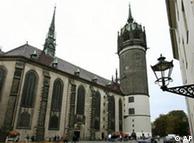 Bildunterschrift: Großansicht des Bildes mit der Bildunterschrift: The castle church in Wittenberg will play a special part in Luther Decade celebrations
Bildunterschrift: Großansicht des Bildes mit der Bildunterschrift: The castle church in Wittenberg will play a special part in Luther Decade celebrations
Mark Hanson, president of the Lutheran World Federation and a resident of Chicago, will give the sermon at Sunday's special church service -- in the Schlosskirche, naturally.
Before that, however, Wittenberg theologian Friedrich Schorlemmer and Christopf Stoelzl, previously Berlin's top cultural official, will engage in a disputation titled "Jesus Was Revolutionary; The Church Became Conservative."
The venue is the Lutherhaus, the house where Luther lived which is now a museum on the Reformation.
A cycling trio will help kick off the Luther Decade by retracing Luther's path.
On Friday, Ralf Grabsch, a Tour de France participant who was born near Wittenberg, and two other cyclists plan to set off for Wittenberg from St Augustine's Monastery in Erfurt.
Luther joined the Augustinian monastery in 1505 after having been nearly struck dead by lightning.
He took his monastic vows in 1506 and began studying theology in Erfurt in 1507.
Plenty of wine and music will also help mark the passing of half a millennium since Luther's arrival in Wittenberg.
A "monastery fete" is scheduled Saturday in the courtyard of the Lutherhaus. Visitors can have guided tours of the house and seminary.
Luther town
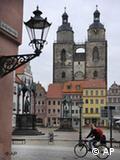 Bildunterschrift: Großansicht des Bildes mit der Bildunterschrift: The Wittenberg market place will be abuzz with visitors come Luther Decade
Bildunterschrift: Großansicht des Bildes mit der Bildunterschrift: The Wittenberg market place will be abuzz with visitors come Luther Decade
The Lutherhaus is on UNESCO's World Heritage List, along with the local church, the Schlosskirche, and the house of Philipp Melanchthon, Luther's friend and fellow Protestant reformer.
Wittenberg's chief industry is Luther-oriented tourism -- the city draws about 400,000 visitors each year -- which it aims to boost during the Luther Decade.
Among the special events planned for next year is a conference on a commemoration of the Reformation in East and West Germany, a play called Luther/Chess, and regular orations in the local church on the theme of the seven days of Creation.
His action sparked the Protestant Reformation.
Wittenberg, a city of some 47,000 souls on the Elbe river between Berlin and Leipzig, launches the Luther Decade this weekend in the run-up to the Reformation's 500th anniversary.
The celebrations begin
The dramatic opening is set for Saturday, Sept. 20, with a reenactment of Luther's arrival on the banks of the Elbe.
The festivities will then move into the city, where the locals and many guests will celebrate the famous theologian.
A special church service is planned for Sunday. Lectures, exhibitions, festivals and concerts will be held at various places in the coming years up to 2017, the anniversary of Luther's posting of his theses.
"We're expecting a few thousand people from all over the world at the weekend," said Johannes Winkelmann, director of the cultural society WittenbergKultur. The guests will include numerous prominent theologians.
 Bildunterschrift: Großansicht des Bildes mit der Bildunterschrift: The castle church in Wittenberg will play a special part in Luther Decade celebrations
Bildunterschrift: Großansicht des Bildes mit der Bildunterschrift: The castle church in Wittenberg will play a special part in Luther Decade celebrationsMark Hanson, president of the Lutheran World Federation and a resident of Chicago, will give the sermon at Sunday's special church service -- in the Schlosskirche, naturally.
Before that, however, Wittenberg theologian Friedrich Schorlemmer and Christopf Stoelzl, previously Berlin's top cultural official, will engage in a disputation titled "Jesus Was Revolutionary; The Church Became Conservative."
The venue is the Lutherhaus, the house where Luther lived which is now a museum on the Reformation.
A cycling trio will help kick off the Luther Decade by retracing Luther's path.
On Friday, Ralf Grabsch, a Tour de France participant who was born near Wittenberg, and two other cyclists plan to set off for Wittenberg from St Augustine's Monastery in Erfurt.
Luther joined the Augustinian monastery in 1505 after having been nearly struck dead by lightning.
He took his monastic vows in 1506 and began studying theology in Erfurt in 1507.
Plenty of wine and music will also help mark the passing of half a millennium since Luther's arrival in Wittenberg.
A "monastery fete" is scheduled Saturday in the courtyard of the Lutherhaus. Visitors can have guided tours of the house and seminary.
Luther town
 Bildunterschrift: Großansicht des Bildes mit der Bildunterschrift: The Wittenberg market place will be abuzz with visitors come Luther Decade
Bildunterschrift: Großansicht des Bildes mit der Bildunterschrift: The Wittenberg market place will be abuzz with visitors come Luther DecadeThe Lutherhaus is on UNESCO's World Heritage List, along with the local church, the Schlosskirche, and the house of Philipp Melanchthon, Luther's friend and fellow Protestant reformer.
Wittenberg's chief industry is Luther-oriented tourism -- the city draws about 400,000 visitors each year -- which it aims to boost during the Luther Decade.
Among the special events planned for next year is a conference on a commemoration of the Reformation in East and West Germany, a play called Luther/Chess, and regular orations in the local church on the theme of the seven days of Creation.


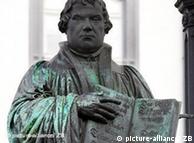
沒有留言:
張貼留言
注意:只有此網誌的成員可以留言。